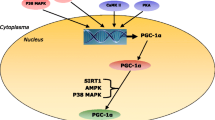Abstract
During the past 30 years, considerable progress has been made in our understanding of the cellular and molecular factors regulating fuel metabolism during exercise. In particular, advancements in the fields of exercise biochemistry and cell signalling have helped elucidate the mechanism(s) by which perturbations in energy status are monitored inside contracting muscle cells, and have helped identify target molecules that increase fuel supply to maintain adenosine triphosphate concentration. In this brief commentary, we summarise some of the major cellular and molecular adaptations in human skeletal muscle resulting from the intense endurance training required to run a marathon.
Similar content being viewed by others
References
Fink WJ, Costill DL, Pollock ML. Submaximal and maximal working capacity of elite distance runners. Part II: nursclefiber compositon and enzyme activities. Ann N Y Acad Sci 1977; 301: 323–7
Hawley JA. Adaptations of skeletal muscle to prolonged, intense endurance training. Clin Exp Pharmacol Physiol 2002; 29: 218–22
Hood DA, Irrcher I, Ljubicic V, et al. Coordination of metabolic plasticity in skeletal muscle. J Exp Biol 2006; 209: 2265 75
Holloszy JO, Coyle EF. Adaptations of skeletal muscle to endurance exercise and their metabolic consequences. J Appl Physiol 1984; 56: 831–8
Costill DL, Fink WJ, Flynn M, et al. Muscle fiber composition and enzyme activities in elite female distance runners. Int J Sports Med 1987; 8 Suppl.: 103–6
Hawley JA, Hargreaves M, Zierath JR. Signalling mechanisms in skeletal muscle: role in substrate selecfion and muscle adaptation. Essays Fireboat 2006; 42: 1–12
Hawley JA, Zierath JR. Integration of metabolic and nutogenic signal hansduction in skeletal muscle. Exerc Sport Sci Rev 2004; 32: 48
Nielson JN, Mustard KJ, Graham DA, et al. 5’-AMP-activated protein kinase activity and subunit expression in exercisetrained human skeletal muscle. J Appl Physiol 2003; 94: 631–41
Reznick RM, Shulman GI. The role of AMP-activated protein kinase in mnochondrial biogenesis. J Physiol 2006; 574: 33–9
Wright DC, Han DH, Garcia-Roves PM, et al. Exercise-induced mnochondrial biogenesis begins before the increase in muscle PGGla expression. J Biel Chem 2007; 282: 194–9
Acknowledgements
John A. Hawley is a contracted researcher for Glaxo-SmithKline (UK).
Author information
Authors and Affiliations
Corresponding author
Rights and permissions
About this article
Cite this article
Hawley, J.A., Spargo, F.J. Metabolic Adaptations to Marathon Training and Racing. Sports Med 37, 328–331 (2007). https://doi.org/10.2165/00007256-200737040-00014
Published:
Issue Date:
DOI: https://doi.org/10.2165/00007256-200737040-00014




